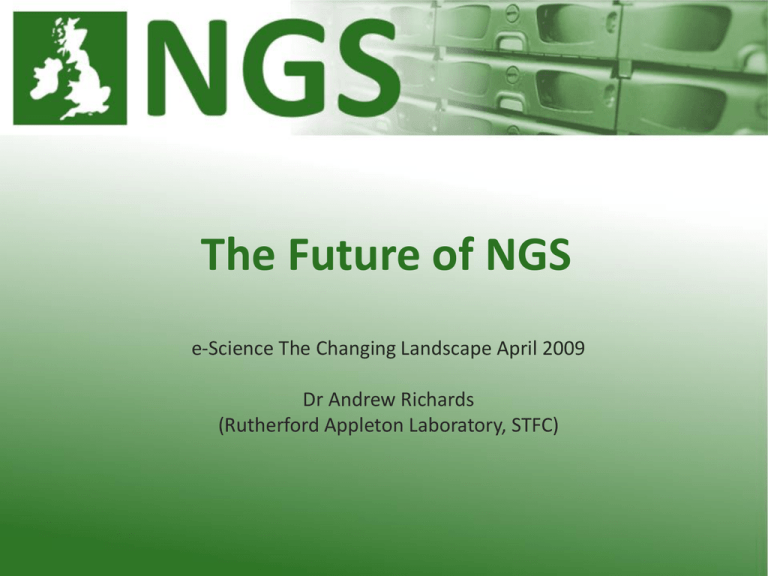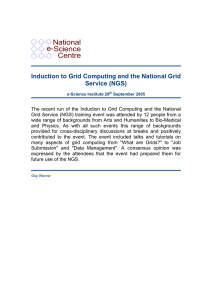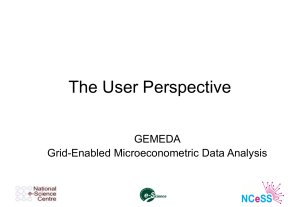The Future of NGS e-Science The Changing Landscape April 2009
advertisement

The Future of NGS e-Science The Changing Landscape April 2009 Dr Andrew Richards (Rutherford Appleton Laboratory, STFC) Overview • History of the NGS • NGS today – Phase 3 and the Future A Brief History of Time • 2001 - UK e-Science Grid – GridPP and others start • 2003 - Initial grid service ITT – 4 independent clusters to investigate provision of a grid service • April 2004 - NGS pre-production service – EGEE, GridPP-2 • August 2004 – GOSC proposed – Coordinating NGS and providing central services • September 2004 - NGS production service / GOSC • April 2006 – NGS/GOSC phase 1 review • May 2006 - NGS phase-2 approved – More integrated programme – EGEE-2 starts in April • October 2006 – NGS phase-2 • April 2009 – NGS Phase 3 (transition to service) Phase 3 • £3M over 2 years (JISC + EPSRC) – (Edinburgh, Manchester, Leeds(WRG), Oxford, STFC) • Focus on HEI – Supporting HEI to join NGS and to support local communities • EGI / NGI – Interoperation with GridPP + Others Aims and Objectives • The mission of the NGS is: – To enable coherent electronic access for UK researchers to all computational and data based resources and facilities required to carry out their research, independent of resource or researcher location. • To be successful, these activities must be increasingly embedded in the routine operations of UK HEI’s and research organisations. – Expanded partner engagement, broader uptake of services and distribution of activities. UK e -Infrastructure Regional and Campus grids HPCx + HECtoR Users get common access, tools, information, Nationally supported services, through NGS Community Grids Integrated internationally LHC VRE, VLE, IE ISIS TS2 The NGS Member Institutions, March 2009 7 Overall Approach • Support an open standards based infrastructure • Develop and operate a policy and best practice framework for the operation, inter-operation and sharing of research computing services across the UK. • A repository of appropriate user and system documentation. • The ongoing review of member services • A UK help desk and support centre, integrated into related international developments • Operation of the core services required to support coherent exploitation of the full range of UK e-resources for research • Targeted training and outreach NGS will • Deploy and support the services required to operate collaborative data and computation services in the UK • Encourage and support integrated (SSO+grid) access to the full range of the UK’s computation, data and other appropriate research facilities. • Providing support and training for inter-institutional e-research. • Expand the community of e-infrastructure resource providers. • Disseminate best practice in operation and use of e-infrastructure. • Interface to partner international (grid) infrastructures. • Collaborate with other national and international e-infrastructures in appropriate research, development, standardisation activities which form synergies with the NGS and its mission. • Develop the business models and plan for sustaining the infrastructure required to support UK researchers. Some value added services • • • • • • Common interfaces Distributed virtualised data storage and access Monitoring and sysadmin support Accounting Resource brokering Application Hosting – Traditional – Web service – Application Portal • International gateway – EGI – International electronic identity Challenges • To drive the adoption of open standards – Limited support for proprietary systems • Enabling access to wide range of resources – Expanding partner programme • Integrating HEI resources and researchers – Partner and user outreach • Enabling community-led support programmes. – Work with closely with research leaders and projects • Promote and facilitate training – Outreach, training, roadshows, PR QUESTIONS ?


